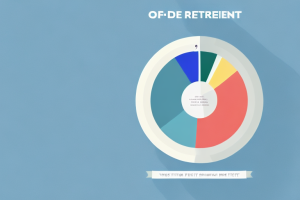The 90 10 retirement rule is a widely discussed concept in the world of personal finance and retirement planning. It proposes a strategy where individuals allocate 90% of their retirement savings to low-risk investments, such as bonds or cash, while the remaining 10% is invested in higher-risk assets, such as stocks.
Understanding the concept of the 90 10 retirement rule
The 90 10 retirement rule is based on the principle of balancing risk and reward. By allocating the majority of your retirement savings to low-risk investments, you aim to provide a more stable and secure financial foundation for your retirement years. At the same time, the allocation of a smaller percentage to higher-risk investments offers the potential for greater returns.
Following this rule, individuals can mitigate the risk associated with market fluctuations, economic downturns, and other unpredictable events. By maintaining a significant portion of their savings in low-risk investments, they are better prepared to weather financial storms and preserve their nest egg for their retirement needs.
Exploring the origins of the 90 10 retirement rule
The origins of the 90 10 retirement rule can be traced back to the work of renowned investor and author, Benjamin Graham. Graham, widely regarded as the father of value investing, advocated for a conservative approach to investment and believed in the importance of preserving capital.
Over time, this concept has gained popularity and garnered attention as a viable retirement strategy. Many financial experts and advisors now endorse the 90 10 retirement rule as a method of achieving a balance between capital preservation and potential growth.
How does the 90 10 retirement rule work?
The 90 10 retirement rule involves a deliberate distribution of retirement savings across different asset classes. The 90% allocated to low-risk investments serves as a safety net, providing stability and protection against market downturns. These investments typically include bonds, certificates of deposit (CDs), and money market accounts.
The remaining 10% allocated to higher-risk investments offers the potential for higher returns. These investments generally include stocks, equity mutual funds, or other assets that have historically demonstrated a higher level of volatility. The objective is to take advantage of the growth potential of these assets while carefully managing the associated risks.
The benefits of following the 90 10 retirement rule
One of the primary benefits of following the 90 10 retirement rule is the balanced approach it provides. By diversifying your portfolio and reducing your exposure to higher risk assets, you can potentially protect a significant portion of your retirement savings while still benefitting from potential growth opportunities.
Additionally, adhering to this rule can help minimize the impact of market fluctuations. During periods of market volatility, the stability of low-risk investments can provide a sense of security, while the exposure to higher-risk investments allows for potential gains when market conditions improve.
Common misconceptions about the 90 10 retirement rule
Despite its potential benefits, the 90 10 retirement rule is not without its misconceptions. One common misconception is that the rule guarantees a certain level of returns or protects against all losses. It is important to understand that investing inherently involves risks, and while the 90 10 rule aims to manage these risks, it does not eliminate them entirely.
Another misconception is that the 90 10 retirement rule is a one-size-fits-all strategy. In reality, each individual’s financial situation and risk tolerance should be considered when implementing any retirement strategy. The 90 10 rule can serve as a general guideline, but it may need to be customized and adjusted to align with specific goals and circumstances.
Is the 90 10 retirement rule right for you?
Deciding if the 90 10 retirement rule is right for you requires careful consideration of your financial goals, risk tolerance, and time horizon. While this strategy can be suitable for many individuals, it is essential to consult with a financial advisor to assess its compatibility with your unique circumstances.
Your financial advisor can help evaluate your risk profile, analyze your retirement goals, and recommend an appropriate asset allocation strategy. They will take into account factors such as your age, future income needs, and existing retirement savings to determine if the 90 10 retirement rule aligns with your overall financial plan.
Implementing the 90 10 retirement rule: Step-by-step guide
If you and your financial advisor determine that the 90 10 retirement rule is suitable for your situation, here is a step-by-step guide on how to implement it:
1. Assess your financial goals and risk tolerance: Determine your retirement goals and evaluate your comfort level with taking on investment risks.
2. Evaluate your current portfolio: Review your existing retirement savings and investments to determine their allocation across different asset classes.
3. Determine your target allocation: Decide on the specific percentage you would like to allocate to low-risk and high-risk investments based on the 90 10 rule.
4. Rebalance your portfolio: Adjust your current investments to match the desired asset allocation. Sell or buy assets as necessary to achieve the 90 10 ratio.
5. Monitor and review: Regularly monitor your portfolio and review its performance. Adjust your allocation if needed to maintain the desired ratio or adapt to changing market conditions.
Tips for maximizing your savings using the 90 10 retirement rule
To make the most of the 90 10 retirement rule, consider the following tips:
1. Start early: The power of compounding can significantly enhance your retirement savings. The earlier you begin investing, the more time your investments have to grow.
2. Automate your savings: Set up automatic contributions to your retirement accounts to ensure consistent savings. This eliminates the temptation to spend the money elsewhere.
3. Reinvest dividends and interest: Instead of cashing out dividends or interest payments, reinvest them back into your portfolio to benefit from compounded growth.
4. Seek professional guidance: Consulting with a qualified financial advisor can provide valuable insights and help you make informed decisions.
Adjusting your investment strategy to align with the 90 10 retirement rule
The distribution between low-risk and high-risk investments under the 90 10 retirement rule is not static and should be periodically reviewed. As you get closer to retirement, you may consider gradually reducing the allocation to higher-risk investments to preserve the capital you have accumulated.
Additionally, changes in your financial situation, risk tolerance, or market conditions may warrant adjusting your current investment strategy. It is important to regularly reassess and make modifications as needed to ensure your portfolio remains aligned with your goals.
Pitfalls to avoid when following the 90 10 retirement rule
While the 90 10 retirement rule can be an effective strategy, there are a few common pitfalls to be aware of:
1. Neglecting to diversify within asset classes: Even within the high-risk investment portion of your portfolio, diversification is crucial. Consider diversifying across different industries, regions, and investment types to spread risk more effectively.
2. Emotional decision-making: Avoid making investment decisions based on short-term market fluctuations or emotional reactions. Stick to your long-term plan and resist the urge to make impulsive changes.
3. Failing to stay informed: Keep yourself updated on financial news, economic trends, and changes in your investments. Regularly review your investment performance and re-evaluate your strategy if necessary.
Expert opinions on the effectiveness of the 90 10 retirement rule
Financial experts have varying opinions on the effectiveness of the 90 10 retirement rule. While some endorse the concept, others argue that it may not be suitable for everyone or that alternative strategies could yield better results.
It is essential to consider multiple viewpoints and seek professional advice when determining the ideal retirement strategy for your specific circumstances.
Case studies: How individuals have successfully applied the 90 10 retirement rule
There are numerous real-life examples of individuals who have successfully applied the 90 10 retirement rule and achieved their retirement goals. These case studies can provide valuable insights and inspiration for those considering adopting this strategy.
While individual circumstances may differ, studying success stories can offer practical lessons and help you identify potential pitfalls to avoid.
Exploring alternative approaches to retirement savings: Comparing the 90-10 rule with other strategies
The 90 10 retirement rule is just one of several investment strategies available for retirement savings. Alternative approaches, such as the 60 40 rule (which emphasizes a slightly higher allocation to stocks) or target-date funds, may also be worth considering.
Each strategy has its own benefits and drawbacks, and the most suitable approach will depend on your specific financial goals, risk tolerance, and other personal factors. Consulting with a financial advisor can help you evaluate different strategies and determine the best one for you.
The role of risk management in the context of the 90-10 retirement rule
Risk management is a critical aspect of the 90 10 retirement rule. By allocating a significant portion of your portfolio to low-risk investments, you are proactively managing risk and aiming to protect your capital.
Over time, the focus of risk management may shift from growth to preservation, as you approach retirement age and become more dependent on your savings. Regularly evaluating your investments and adjusting your strategy can help ensure that risk is effectively managed throughout your retirement journey.
Analyzing potential drawbacks and limitations of the 90-10 retirement rule
While the 90 10 retirement rule has its merits, it also has potential drawbacks and limitations to consider:
1. Reduced growth potential: While the emphasis on low-risk investments provides stability, it may limit the growth potential of your portfolio. Those seeking higher returns may need to explore more aggressive investment strategies.
2. Inflation risk: The conservative nature of the 90 10 retirement rule may expose your retirement savings to the risk of not keeping up with inflation over the long term. It is crucial to assess whether your investment strategy adequately accounts for inflation to ensure your purchasing power is preserved.
3. Personal circumstances: The 90 10 retirement rule may not be appropriate for everyone. Those with a greater risk tolerance or individuals with specific financial goals may need to modify the rule to best suit their needs.
Frequently asked questions about the concept and implementation of the 90-10 retirement rule
Here are answers to some frequently asked questions about the 90 10 retirement rule:
1. Is the 90 10 retirement rule suitable for all ages?
The 90 10 retirement rule can be applied at any age, but the specific allocation percentages may vary depending on factors such as risk tolerance, time horizon, and retirement goals. Consult with a financial advisor to determine your ideal allocation.
2. Can the allocation percentages in the 90 10 retirement rule change over time?
Yes, the allocation percentages can be adjusted over time. As retirement approaches, it may be prudent to reduce the percentage allocated to higher-risk assets in favor of a more conservative allocation that seeks to preserve capital.
3. Are there any tax implications associated with the 90 10 retirement rule?
Tax implications can vary based on the specifics of your investments and the type of retirement accounts you hold. Consult with a tax advisor to determine how the 90 10 retirement rule may impact your tax situation.
Adapting and customizing the principles of the 90 10 retirement rule to fit your financial goals
The principles behind the 90 10 retirement rule can be adapted and customized to align with your specific financial goals. Working with a financial advisor, you can assess your risk tolerance, time horizon, and retirement objectives to personalize the rule’s application to suit your needs.
Remember, the 90 10 retirement rule is a guideline, not a rigid requirement. Flexibility and customization are key to developing a retirement strategy that best serves your individual circumstances.
In conclusion, the 90 10 retirement rule can be a valuable tool in managing your retirement savings. By striking a balance between low-risk and high-risk investments, you can aim to protect your capital while still pursuing growth. However, it is crucial to consider individual factors, seek professional advice, and regularly review and adjust your strategy to ensure it aligns with your evolving financial goals and risk tolerance.



